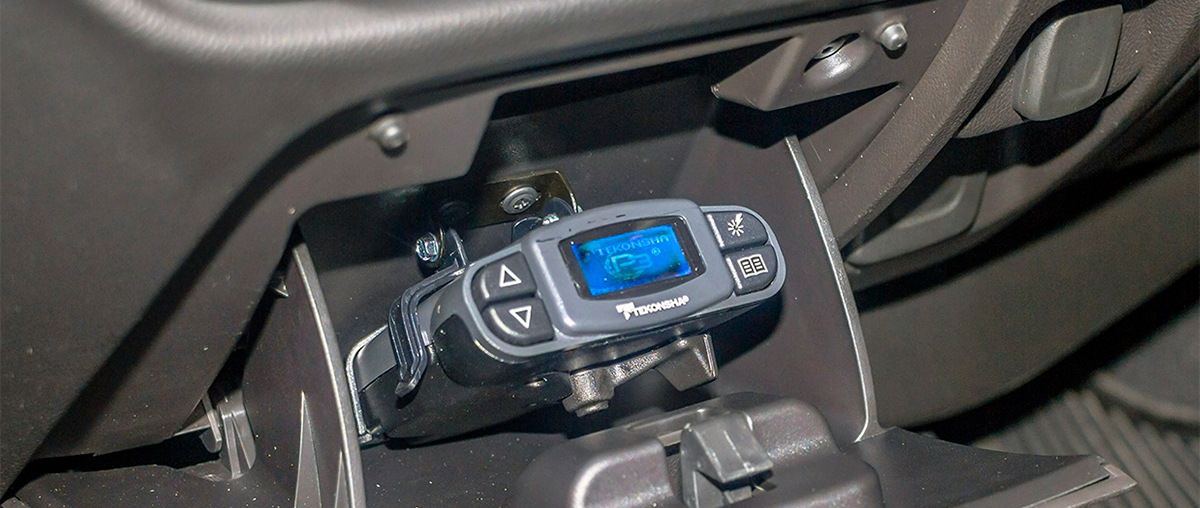
If you drive a car or a truck with a trailer attached, a good brake controller is essential to tow your trailer smoothly and safely. When the road is rough and even, it is much more complicated for a driver to control the trailer and tow it carefully. The brake controller contributes to increased braking power, allowing the trailer to come to a complete stop at the appropriate time.
Below, you can discover 7 most sought-after brake controllers made by internationally recognized companies and find out what is the best trailer brake controller.
Trailer Brake Controller Reviews
Tekonsha 90195 P3 — Best Electric Trailer Brake Controller
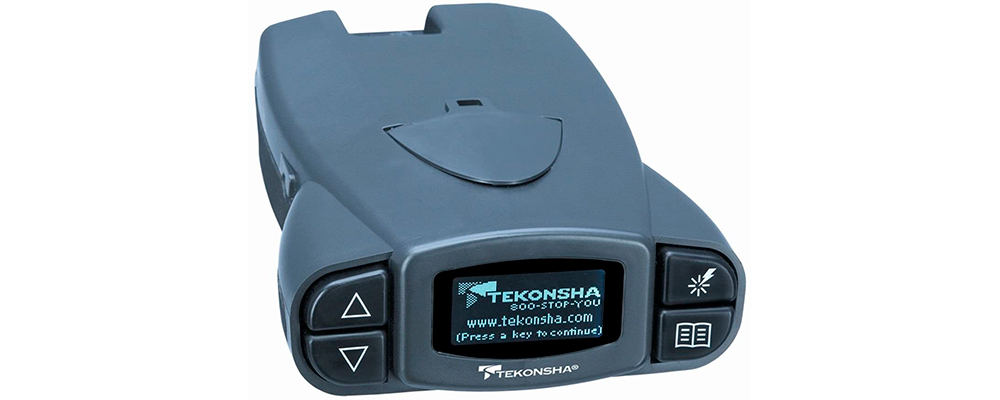
The first product on our list comes from Tekonsha which is famous for the most advanced and handy equipment. The Tekonsha 90195 P3 has every potential of becoming the best brake controller on the market because of an incredible level of customization and multi-functionality.
The device has a simple but modern design. The LCD screen allows keeping track of charge, output voltage, and output current. The screen has various color options and supports three languages. The P3 is programmed to warn the user in case the trailer brakes fail to operate correctly. This characteristic plays a crucial role in preventing road accidents and collisions.
The electronic brake controller is compatible with electric and electric-over-hydraulic trailers. The P3 is expected to handle up to 4 trailer axles at a time. This is of great value for those drivers who own or have to deal regularly with different trailer configurations. Despite the advanced and user-friendly design, the Tekonsha 90195 P3 still can be controlled manually if necessary. You can adjust level brakes to reach the optimal performance. The device is portable and compact, but the small size does not impair the power of brake control.
Along with the Tekonsha, the user gets some helpful accessories, such as plug adapters and mounting clips to attach and detach the device.
Pros
- Set-up is easy.
- You can set the brightness and background color of the display.
- You may use the self-diagnostic system if you are concerned about the state of your brakes.
Cons
- The price point is a bit higher in comparison with other alternatives on the market.
Tekonsha 90160 Primus IQ — Best Proportional Trailer Brake Controller
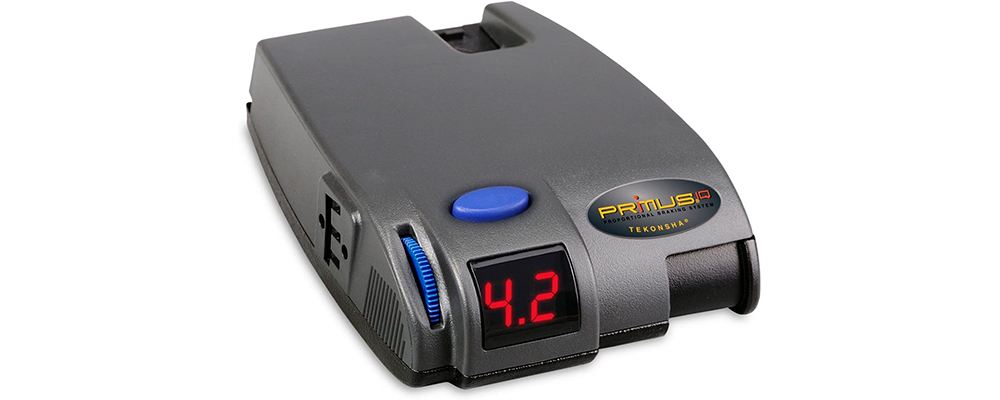
Tekonsha brand offers one more option that can be fairly ranked among the best trailer brake controllers in the world.
The design is a lot similar to that of the Tekonsha 90195 P3. The core technology is basically the same. The device is programmed to run automatically using a self-diagnosis. The LED display allows tracking the braking condition and informs of any malfunctions immediately. The readout on the screen normally provides information on output voltage, output current, and reliability of the electrical connection. The Boost feature helps enhance the initial braking power, but the driver cannot level braking during the performance. This model is expected to work with up to 3 axles and adjust to any road surface, including slopes and rough roads.
The device is compact and user-friendly. The Plug-N-Play port enables secure and solid connection with a heavy van, whereas mounting clips make the removal smooth and quick. Primus IQ comes with a number of mounting clips for easier and firmer trailer brake controller installation.
This proportional controller does not have all of the advanced features that you can see in pricier models. If you’re looking for a basic gadget that will do a good job in towing a trailer, the Tekonsha 90195 P3 will exceed your expectations.
Pros
- The price is suited to buyers on a low budget.
- Installation is pretty simple.
Cons
- Primus IQ does not involve different performance modes to match trailer profiles better.
Reese Towpower 8508211

This versatile brake controller device is easy to mount and control; it has a battery protection mechanism and an LED display. It’s also one of the more affordable options, which makes it a viable contender for the best brake controller for a travel trailer. It may not have all of the capabilities of more costly models (like customizable settings and a color screen) while representing a reliable cheap alternative.
The device controls braking on up to 4 axles, allowing it to be used for a variety of trailer types. It’s based on the principle of proportional braking effort application and makes braking smooth and reliable. The LED display lets you set the braking gin with regard to your load, which works well both for empty trailer towing and towing the one with furniture and some camping equipment and supplies. The boost button also provides good security for emergency situations. I used it once when driving downhill with the loaded trailer and felt the impact right away.
Another feature worth mentioning in this electric brake controller review is the protection against reverse circuits and poor grounding. This, together with the plug-and-play installation, makes the tool beginner-friendly. While you’ll have to connect it to a harness specific to your car model, there’s nothing to do afterward, except adjust the settings. The display shows the power output to brakes in real-time and lets you control it.
Pros
- It works well even with a low voltage signal.
- The controller is compact (4 x 2.75 x1 inches) and fits in nearly any dash.
- The LED screen receives information regarding the brake failure.
Cons
- When the gadget is turned on, the LED screen remains illuminated at all times.
- Some vehicle models might need an adapter (wire extension) to connect the controller due to the different lengths of wire and the layout of connector pins.
Reese Towpower 8507111
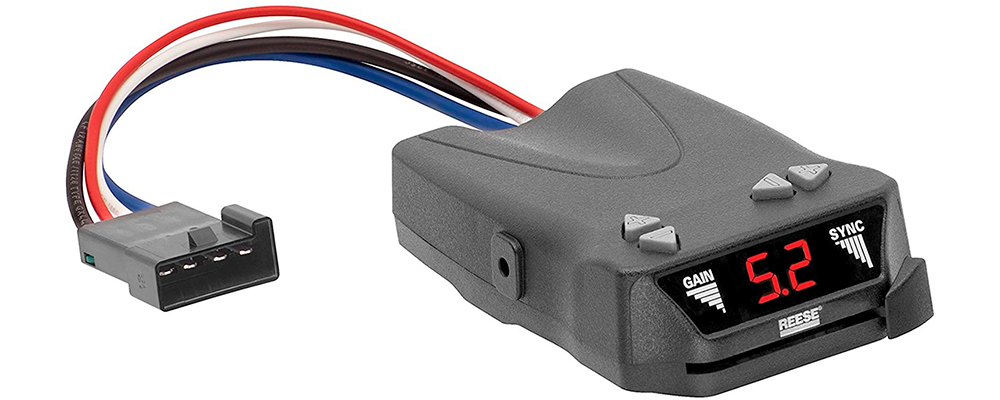
A low price and adjustable options might make this device the best trailer brake controller. Its mechanism, on the other hand, is activated in a progressive way, which means there’s no synchronization with the vehicle in gain. Still, if you’re used to such controllers, this one is one of the good options.
The controller has a solid-state display letting you see the voltage and set the features to match your driving style. You can dial any level from 1 to 10 for lightweight or heavy loads and also choose the time of trailer braking activation (sync option) after you press the car’s brake. The controller also features the emergency braking option letting you manually apply the trailer’s brakes without or in addition to pressing the vehicle’s brakes.
With most vehicle models, you don’t have to worry about reverse battery or other electrical system issues, as the controller is protected against poorly grounded connections and short circuits.
The installation of this RV electric brake controller is quite easy, though you might need to have a harness specific for your model. Applying the extending adapter also simplifies the installation and makes it a plug-n-play one. I’d recommend this controller for occasional trips with not too heavy loads over the relatively level terrain. It does its job well on the hills, too, although progressive braking type requires some time getting used to and a thorough driver’s attention.
Pros
- It can be applied to any number of axles from 1 to 4.
- Performs the braking system diagnostics and notifies of failures, if any.
- The protuberant buttons allow you to easily manage the controller.
Cons
- It doesn’t apply all braking power at an emergency stop, if set to a lower output level.
- It interferes with the radio sometimes.
CURT 51110
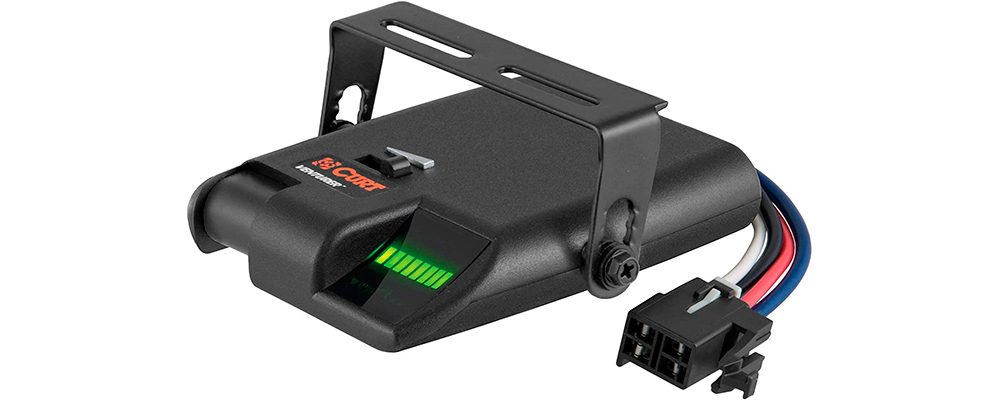
If you’re used to time-based brake controllers, CURT 51110 is the model to consider. It’s priced low while having all the necessary features like emergency braking, gain and sensitivity settings, and automatic level adjustment. It doesn’t interfere with other braking appliances and mechanisms within your car’s electric system (like anti-lock, cruise control, PWM). Taking into account multiple installation options, it can be called the best electric brake controller. Still, for heavy-duty towing, it’s advisable to look for more expensive inertia-based controller models.
With a height of 7/8-inch, the gadget is thin. it’s 4-inch long and 3 ¼-inch wide, letting you put it anywhere on your car’s dash. Installation is quick, as unlike controllers with the proportional braking mechanism, it doesn’t require leveling and may be mounted at an angle. The connection wires are packed into a 4-pin plug that requires a harness to be hooked up to a car. Once the harness is there, it gets plugged without further ado.
The display on this device is LED with a green and red indicator. The number of lit indicator parts reflects the power output to the brake. The gain and sensitivity of braking are set via the convenient large toggle button on the left. The emergency braking slider is bulging on top of the controller.
CURT 51110 can be used for 2, 4, and 6 brakes (1-3 axles). For the price, this controller is quite versatile and deserves its high position among electric brake controller reviews.
Pros
- It provides high power output to brakes even in low-voltage systems.
- Flashes red if disconnected from the braking system.
- Supplied with the adjustable mounting bracket, overlapping style.
Cons
- Sensitivity is a bit too high, it requires getting used to before finding a sweet spot.
- A bit too long for putting under the steering wheel (it can bump into a knee).
CURT 51140 TriFlex
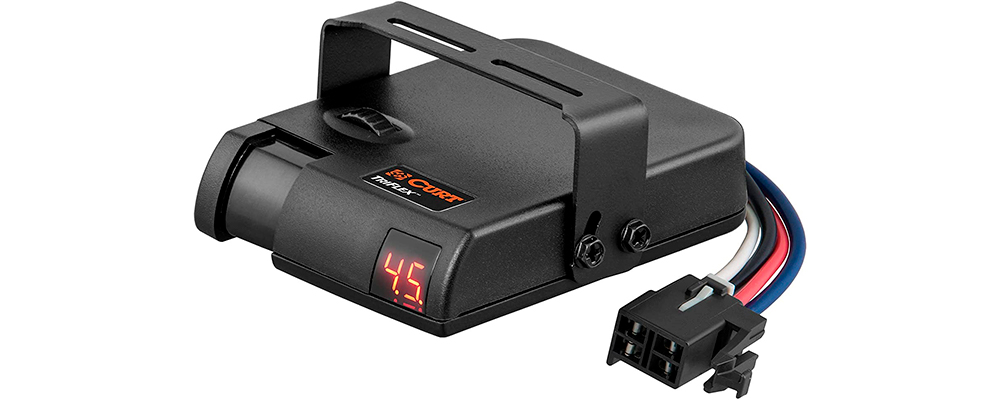
If you agree to buy only a high-class digital brake controller that includes all the newest characteristics of intelligent braking, the TriFlex is the first decent model to consider.
CURT created a special circuit-based design that involves the analysis of a trailer movement and a road surface based on which the system defines and sets the most optimal level of braking power. The braking system has 9 braking levels to match different trailer configurations. The driver can manually activate the necessary level and set the output power. The CURT 51140 system is compatible with other essential vehicle control systems such as anti-lock brakes and low-voltage systems.
The TriFlex is versatile in terms of application. You can use it for a large variety of vehicles of different weight. In spite of a small size, this proportional model delivers excellent performance and can tow a trailer with up to 4 axles.
The housing is smartly designed and features a small digital display showing the adjustment degree. The CURT 51140 comes with the necessary hardware to install the device correctly and quickly. The device can be mounted at any angle, but the most optimal arrangement is below the steering wheel.
Pros
- Set-up is fast and takes less than a minute even for newbies.
- The system envisages automatic leveling and calibration if necessary.
- The price point is budget-friendly.
Cons
- There is no adapter cable in the kit.
Reese Towpower (74642)

Out of all the trailer brake controller reviews on this list, this model is the only one that is aimed to deal with single and tandem axle trailers. Though it does not feature a brightly lit LED display, the driver can enjoy other tech advantages such as enhanced durability and powerful braking abilities.
The Reese Towpower is small and can be mounted in any position. The box is made of high-quality solid materials that make the 74642 model durable and promise a prolonged lifespan. The device needs no leveling but can be slightly manually controlled in some instances. Unlike other brake controllers, this one is not proportional but time-based, which means the user is able to apply braking power only at a fixed rate.
The design is fully compatible with the latest safety standards. So if you are bothered about braking performance, this model offers fail-safe performance with the minimal of malfunction and won’t let you down at the right moment. The Reese Towpower is accompanied by a set of essential hardware for easy and obstacle-free installation.
Pros
- The design allows sync adjustment to various trailer configurations.
- The user’s manual is straightforward and concise.
- The price is the lowest one among all the options here.
Cons
- The unit lacks an adaptor to connect a trailer. You will have to buy it separately.
Buyer’s Guide
What is a Trailer Brake Controller?
A trailer brake controller is a device that is mounted in a tow vehicle and applied to a trailer’s brakes to halt the trailer when needed. There are two types of brake controllers: proportional and time-delayed.
A proportional brake controller relies on an inertia-based sensor or so-called accelerometer. Once you start slowing down and hit the brakes, it stops the trailer’s brakes too. The advantages of this type of device are the ability to adjust braking power and simultaneous operation with a vehicle’s brakes.
A time-delayed brake controller requires the driver to set the brake power and the sync (how hard you are hitting the brakes). The brake power won’t reach the trailer’s brakes immediately after you applied the brakes. Normally, there is a delay between the moment you press on the brakes and the moment your trailer actually stops. They are considerably cheaper in comparison to proportional ones, but they offer less efficiency and safety when towing a trailer.
How does a Trailer Brake Controller Work?
Basically, a brake controller helps the driver find out a vehicle’s speed and how much braking power is needed to bring a trailer to a halt. The built-in display monitors the connection and the voltage level. More advanced brake controllers have a self-diagnostic system that gives even more information about the trailer brakes. Based on that, the driver can estimate how fast the trailer is going and how hard they should hit the pedal.
Most states require having a trailer brake controller in a vehicle because the risk of collision is usually high when drivers try towing trailers without proper equipment. When choosing such a device, you should take into account the weight of your trailer. The heavier a trailer you drive, the more powerful a device must be to handle towing safely.
How to Install Trailer Brake Controller?
Electric brake controller installation is easy even for green drivers. However, you should know the right place to mount it. The most advantageous arrangement is generally under a driver’s dashboard to keep the display in sight. However, not every model can be installed in any orientation. Proportional controllers are sensitive to driving and cannot be located upside down and must be placed only at specific angles.
If you know where to install the brake controller in your vehicle, you might be confused about numerous wires. This problem is typical for drivers who are only learning how to tow a trailer. Manufacturing companies typically care about their customers and try to provide users with the most detailed information on operation and maintenance. Before you begin setting up your brake controller, you should carefully read the instruction booklet. Pay attention to the part which indicates where you should plug in each wire.
Follow these steps to perform the installation successfully.
- First, make sure that the cables at the back of your car are connected.
- Mount the brake controller under the dashboard connecting each wire in the right place.
- Turn on the ignition and see to it that the display indicates the maximum gain. You can adjust it with the buttons if necessary.
- At last, you should mount a plug connector in the vehicle. Make sure it is solid and reliable.
Trailer brake controller wiring is a complicated task, especially for a beginner. The controllers usually have a 4-wire configuration with the following connectors:
- Trailer feed — sends the power of the brake to the trailer connector
- Ground — links the brake controller to the grounded source (negative)
- Brake switch — turns on power after the brake pedal is pushed
- Battery power — enables the brake controller with power
Keep in mind that trailer brake wiring varies depending on the model. To avoid being perplexed by the amount of wires, always refer to a particular schematic that corresponds to a certain model.
How to Use a Trailer Brake Controller?
After you’ve installed a controller successfully, you should set it up based on your trailer configuration. Whether you own the best electric trailer brake controller or a simple one, there are a number of easy steps to follow:
- Check the connection each time you are going to drive even when you are positive the brake controller is in good condition. Your vehicle with a trailer should be on a level surface with no other vehicles nearby.
- Now, you should calibrate the brake controller if it is not able to calibrate itself.
- If you own an intelligent model, it allows choosing individual settings that help customize the device or adjust it to a vehicle. At this point, you should customize your brake controller if possible.
- After starting the ignition, it generates the maximum braking output. Here, you should tune it depending on your vehicle’s load size. In order to change it, you should hit and hold the brakes, then set the initial output.
- Now, you should drive a vehicle at a speed of about 25 mph to ensure the brake controller is tuned correctly. If you see the trailer cannot stop properly, enhance the initial braking power.
- On the contrary, if your trailer stops moving too harshly, lessen the initial output level a bit more.
- Finally, most models have an ‘ON’ switch that lets the driver turn on the controller only when there is a need for it. This manual control is particularly useful when the road surface changes and you have to drive down a rough road. You should take a gravel road, for example, and test how you manage to stop your trailer in this case. Normally, the brake controller allows you to immediately adjust your brakes to a different type of terrain. This substantially reduces the risk of collision and damage caused by bad towing.

My name is Brandon, and I’ve been interested in cars since I was a kid. I got a bachelor’s degree in Automotive Technology and worked in a private car workshop. I have two cars that have been completely upgraded with my own hands. So I successfully put all my knowledge into practice.
Last update on 2023-02-17 / Affiliate links / Images from Amazon Product Advertising API
